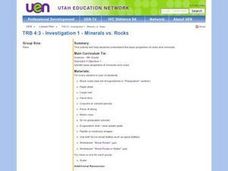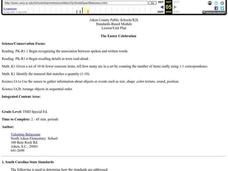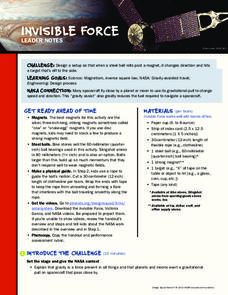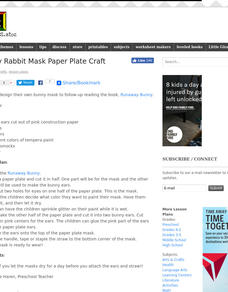Curated OER
Pollen & Pollination
Students identify the different ways things are pollinated and how to manage pollen. In this pollination lesson plan students complete an experiment on how moths pollinate flowers.
Curated OER
Minerals vs. Rocks
Fourth graders are introduced to the characteristics of a variety of minerals and rocks. As a class, they are shown rocks and minerals and asked to describe them as a geologist would. They work together to measure and record their...
Curated OER
Dunk It! Don't Junk It!
Third graders explore the concept of sorting recyclables. In this recycling lesson, 3rd graders determine how to separate recyclables from waste and how to sort recyclables into different categories.
Curated OER
Periodic Table Patterns using Fabulous Periodic
Students explain how elements are arranged in the periodic table. In this chemistry lesson, students group the eggs according to a certain pattern. They compare this to elements in the periodic table.
Curated OER
The Easter Celebration
Students read a short story about Easter. They recognize and point to pictures of the key words (egg, chicken, rabbit, basket, flower). They make an Easter basket and count how many chickens can fit inside. They also practice identifying...
Curated OER
Milk and Dairy Test
Students explore how to select and prepare milk and milk products, identify standard serving size for milk and milk products, review terms associated with milk and milk products, and demonstrate knowledge of how to use and care for these...
Curated OER
Reverse Glass "Painting"
Students examine the life and works of John Audubon. They compare and contrast various pieces of art and identify the purposes of stained glass. After observing his art, they create their own stained glass creation using the concepts...
Curated OER
Life Cycles
Students explore the life cycle of living things through the eight lessons of this unit. The butterfly, frog, chicken, and plant are inspected and form the basis of the work done in this unit.
Curated OER
Sink or Swim
Students define density and explain how to determine the density of an object. Students participate in a demonstration that shows the differences in the densities of different liquids and how they affect the liquid's physical properties.
Curated OER
The Effect of Citrus Oils on Fruit Flies
Students answer the question, "How could citrus fruits be toxic to fruit flies when fruit flies live on fruit?" They conduct an investigation using four different citrus oils and fruit flies and analyze data collected.
Curated OER
Density, Iron, and Anemia
Learners explain what factors determine density. In this physics lesson, students hypothesize which objects are less dense. They cite the importance of density in everyday life.
Curated OER
The City From the Ooze
Students investigate the life in the mud found around ponds. They create Ooze City using pond mud. Students investigate the various layers that form and what type of organisms are in the mud.
Curated OER
Paper, Microorganisms, and Biocides
Students study the paper making process and discuss the implications of recycling paper. Students conduct a lab to determine if microorganisms are present in different solutions used in the papermaking process today.
Curated OER
Finding and Measuring What You Can't See
Students determine how scientists measure pollutants in food and the environment. Students discover how scientists remove one material based on its physical properties. Students figure out how much of a pollutant is present after...
Curated OER
The Life Cycle of the Butterfly
Students examine the life of a butterfly. They write a biography from the point of view of a caterpillar using new vocabulary. They use magnifying glasses to examine butterflies and caterpillars.
Curated OER
Frogs, Fabulous Frogs
Students have the opportunity to both interpret and replicate the different shapes and textures observed in the life cycle of a frog. When students apply the watercolor wash to the crayon texture rubbings the designs take on a...
PBS
Invisible Force
Investigate invisible forces. Young engineers design a setup that changes the direction of a steel ball using a magnetic force. The purpose of the setup is to model the gravitational pull of spacecraft by planetary bodies.
Curated OER
Abe Lincoln's Log Cabin
Students study Abe Lincoln and make a log cabin out of pretzel sticks and chocolate frosting.
Curated OER
Bunny Rabbit
Students design their own bunny mask to follow-up reading the book, Runaway Bunny.
Curated OER
Bird Visual Puns
Students create visual puns. They draw the name of bird from a basket and then create a visual pun illustration based on the bird's name. Students evaluate their drawing using a rubric and then present their work to the class.
Curated OER
Bunny Rabbit
Pupils design their own bunny mask to follow-up reading the book, Runaway Bunny.
Curated OER
Loggerhead Nest Management Program
Students identify the sea turtle management documentary and complete an activity for each slide. They plot the location of nests laid on the island they patrol and discuss their rationale for management decisions. Finally, students...
Curated OER
Everyone can explore architecture
Students draw like an architect. In this interdisciplinary lesson, students research and draw several examples of different forms of architecture through societies, cultures and times, then present them to the class.
























